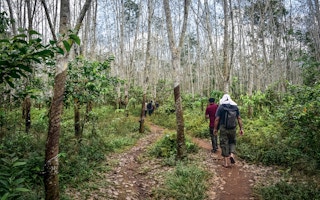Indonesia’s riddle of how to balance environmental responsibility with its rapid development—and the energy and manpower needed to keep up the pace—only seems to raise more conundrums therein.
This ‘food-energy-environment trilemma,’ as Center for International Forestry Research (CIFOR) senior scientist Himlal Baral describes it, is the focus of a research project he’s leading that launched in 2015. The answer is a puzzle of components, but the piece he and his team are examining is bionenergy: energy derived from living organisms, such as trees and herbaceous plants.
If the bioenergy sector plants its roots in sustainable agriculture methods, it can simultaneously help achieve other national targets like food security and greenhouse gas emissions reductions. Rather than growing the sector through the conversion of healthy ecosystems and arable land, the project seeks to establish a new approach of using Indonesia’s degraded lands for bioenergy production, thereby transforming them back into profitable landscapes.
In light of the government’s goal to increase the amount of renewable energy in the national energy mix from 6 per cent in 2005 to 31 per cent by 2030—also aiding it’s program to procure 35,000 MW of electricity by 2030—Baral has presented on his inquiries to the Indonesian House of Regional Representatives, who with interest requested a map of the country’s degraded landscapes, marking which biomass plants would work well where.
This has raised a few main questions for the team to examine, seeing the project extended to the end of 2020 as they continue to research the answers and gather the information the government needs. Which species are most promising for such a goal? How can biofuel and food production be achieved hand-in-hand? What are the impacts of bioenergy production on multiple ecosystem services?
Step one is to figure out which species are best suited for various environments, in terms of carbon storage, growth and yield, and sustainability. This means testing out different species—woody biomass species such as Gliricidia sepium and Calliandra calothyrsus; oil seed trees such as Calophyllum inophyllumand Pongamia pinnata—and in various settings. Some grow and yield more in waterlogged areas as opposed to dry; some thrive in agroforested or mixed settings while others require monoculture. Some store more carbon above-ground while others, below; some have positive effects on surrounding water resources and biodiversity, while others could cause harm.
Once certain species are identified as solid candidates for certain environments, the next step is to convert them into energy. For the scientists, this means calculating greenhouse gas emissions of their conversions as well as all the emissions involved in getting the bioenergy into the market.
And then there’s the market itself. In order to keep more benefits in local communities rather than carried off to others in the value chain, the project also looks at bioenergy business models for small- and medium-sized enterprises (SMEs), potentially involving partnerships with larger businesses and state-owned-enterprises. Investigations into governance and land tenure issues will also seek to give producers proper land security, to better incentivize good land-use practices.
There are a number of challenges that will need to be avoided and addressed, such as keeping bioenergy from competing with food for land use, which can increase food prices and drive up food insecurity if bioenergy crops win out. Poorly planned production can lead to further degradation of forests; use of insecticides and fertilizers can harm the environment and contaminate water sources; and without proper governance, land tenure conflicts can increase.
But with the right crops in the right places, and the right business models to help locals hold onto the profits, bioenergy just may have the power to lift landscapes out of degradation and into the realm of national necessities.
This article was published with permission from Forests News under a Creative Commons’ License.










